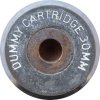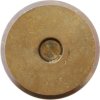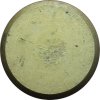My notes on it:
30 x 100B M552 series (WECOM)
During the 1960s, the US Army began a programme for a new cannon of 30 mm calibre, the XM140, intended for the abortive Cheyenne attack helicopter. Development work lasted for about 13 years, with well over 1,000,000 rounds being made, in at least ten variations. The programme was known as the 30 mm WECOM (from the Army's WEapons COMmand).
The first version of the round (rarely seen) uses a fat, bottle-necked rimless 30 x 110 case with 45 mm rim and body diameters and 177 mm overall length, based on the semi-rimmed 1.1 inch US Naval case (but with the body diameter slightly increased to make the case rimless) and proposed by the Picatinny Arsenal. This was soon replaced by the 30 x 100B round described here, which resembles a shortened 30 x 113B ADEN/DEFA round but differs slightly in every dimension (e.g. rim and body diameters 34.5 and 32.5 mm compared with 33.3 and 32.3 for the ADEN/DEFA round). It is 178 mm long and weighs c.410 g. Both brass and aluminium cases were made. The 195 g HE shell was fired at 670 m/s; the chamber pressure was only c.200 MPa. Unlike the ADEN/DEFA rounds, the WECOM used percussion ignition.
The WECOM ammunition was known as the M552 series. The cartridge case was the XM193, with XM639 the TP round and XM640 the TP projectile it fired. The first version of the HEDP round was designated XM552, with the projectile being the XM553. This HEDP projectile was also used in the XM757 round, which used an aluminium case, the XM193B1E1. Other rounds using the XM193 case were the XM554 Practice, Spotting, which fired the XM555 projectile, and the XM250 and XM251 HPT. There were also high-velocity loadings using a modified case, the XM211, which was redesigned internally to resist higher pressures: these rounds were the XM719 TP, firing the XM719 projectile (220 g, at 760 m/s), and the XM717 HEDP firing the XM553 projectile (as mentioned above).
The WECOM ammunition programme was terminated in 1976 in favour of using ammunition compatible with the NATO standard 30 x 113B.
Three rival guns were developed around the WECOM ammunition: the unique XM140, the three-barrel rotary XM188 and the first version of the M230 Chain Gun. The M230 won the competition, was adapted to use the 30 x 113B, and is currently in service in the AH-64 Apache combat helicopter.









